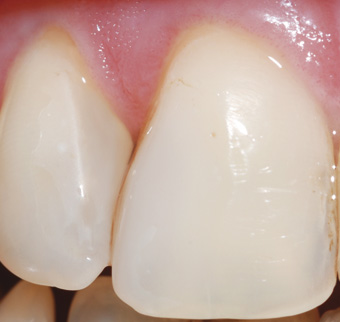Optimal results with your temporaries
A discussion of fabricating direct temporaries with bis-acrylates, by Dr Murad Muradov, Central Research Institute of Dentistry, Moscow
The need and practicability of using temporary crowns for prosthetic restorations has been proven effective in many scientific studies (see literature references 1-5).
Foregoing a temporary restoration can have negative consequences such as pulpitis due to thermal and/or bacterial damage, damage to the TMJ due to abnormal loads, or exposure of the preparation margins due to gingival recession. Similarly, in order to prevent possible drifting of teeth that have no contact with their antagonists, a temporary restoration is highly recommended to stabilise the occlusion.
After a preparation that is not limited to the enamel, saliva contact with the prepared tooth core can lead to bacterial penetration into the exposed dentine tubules which, over time, can cause secondary caries and the deterioration of the prepared core under the crown.
Therefore, following a preparation, the pulp and dentine must be protected against any bacterial damage. The protection of the prepared tooth by means of a temporary restoration is therefore considered mandatory.
A significant progress in the fabrication of temporary crowns is the use of bis-acrylates, which were specifically developed for this purpose. These materials are user-friendly, require a minimal working time and simplify the fabrication of temporaries (Fig 1-9) – thus exhibiting characteristics that are of great significance to both the dentist and the patient.
Besides their ease of use and convenience, these materials offer a number of positive properties that make them particularly well-suited for the fabrication of temporaries, such as low polymerisation temperatures, no residual monomer content, high mechanical strength, a particularly smooth surface, no unpleasant odour and high colour stability.
The fabrication of such a temporary restoration is described in the following case study.
The initial findings revealed a badly damaged crown on tooth 21 (Fig 1). Following a core build-up, the tooth was prepared (Fig 2). In order to prevent gingival bleeding and to obtain an exact reproduction of the preparation margins, retraction cord was placed (Fig 3). If composites are used as core build-up materials, the prepared tooth and the surrounding teeth should be lightly wetted with Vaseline (Fig 4). On the gypsum model, on which a wax-up of the deteriorated tooth 21 was made, a silicone impression for the temporary was taken using Silagum-Putty Fast (Fig 5).
The impression was filled slowly with Luxatemp-Fluorescence to avoid air bubbles. During this process the tip was kept submerged in the material (Fig 6). The Silagum-Putty Fast matrix was reseated within the mouth (Fig 7) and the Luxatemp-Fluorescence temporary allowed to cure for two minutes. The impression was then taken out of the mouth (Fig 8). Then the temporary was taken off the core, excess material removed and the crown margin trimmed with a carbide burr.
The crown margin was outlined with a fine pencil (Fig 9) and the excess material removed, especially in the gingival area, using a fine carbide burr on low speed (Fig 10). The finishing and polishing of the temporary was completed using abrasive brushes (Fig 11). The surface was polished step by step at low speed changing from hard to soft brushes (Fig 12).
Subsequently, the surface of the temporary was varnished with Luxatemp-Glaze & Bond to obtain a natural shine and to minimise plaque deposits on the temporary. If this varnish is used no further polishing is needed. This speeds up the fabrication process.
For the temporary cementation of the crown only a thin layer of TempoCemNE was required because of the temporary’s perfect fit (Fig 13). Subsequently, the temporary was seated (Fig 14).
All the products mentioned in this article are distributed in the UK and Ireland by DMG Dental Products (UK) Ltd.
For further information on these and all the other products available, contact your local dealer or DMG direct on +44 (0) 1656 789 401, fax +44 (0) 1656 360 100, email info@dmg-dental.co.uk or click onto www.dmg-dental.com
REFERENCES
1. Abakarov S.I., Moderne Konstruktionen der festen Zahnprothesen, Moskau, 1994, S. 95.
2. Kalamkarov H.A., Prothetische Behandlung unter Anwendung der metallkeramischen
Prothesen, Moskau, 1996, S. 175.
3. Weiss, Fehler bei prothetischen Behandlungen, Behandlung von Patienten mit unvollständigen, Zahnreihen, Moskau, 2005, S. 408.
4. Givens E.J. Jr, Neiva G., Yaman P., Dennison J.B., Marginal adaptation and color stability of four provisional materials, J. Prosthodont., 2008, Vol.17, 2, P. 97-101.
5. Yu Y.Q., Zou D.R., Su J.S., The study of the monomer release from four kinds of temporary crown material by infrared spectrum, Shanghai Kou Qiang Yi Xue, Shanghai Journal of Stomatology, 2008, Vol.17, 6. 643-647.

